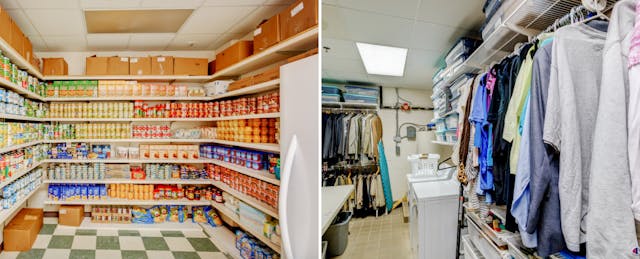It was 2007, and Marietta High School, part of Marietta City Schools outside Atlanta, had just come off Georgia’s “needs improvement” list for low-performing schools. Student test scores and graduation rates in the school had also spiked, marking what all considered the start of a turnaround in the suburban district.
Well, almost all.
Leigh Colburn, then-principal of Marietta High School, the only high school in the district, was encouraged by the gains like anyone else. But she still wasn’t satisfied. She had noticed—and begun to agonize over—the 20 to 25 percent of kids in Marietta who still weren’t graduating. Despite academic reinforcements, those students seemed stuck, and she was beginning to understand why.
Many of these kids were homeless or lacked stable housing. Others were witnessing domestic violence, or experiencing it first-hand. Still others went hungry outside of school hours. These students were dealing with hardships that no amount of tutoring or test prep could compensate for.
“I think what haunted me was that I couldn’t help or do anything about it,” Colburn reflects. “I had kids with real needs, and we didn’t have resources in the building or in our wheelhouse as educators to meet them.”
Instead of taking up the issue with staff at the high school, or even with other leaders in the district, Colburn decided to take an approach that, at the time, seemed novel: She went straight to the students and asked them, “What do you need? What is getting in the way of your learning?”
Those two simple questions were later solidified as the first in a seven-step process Colburn now calls the “Centergy cycle,” which makes student voice the central component in helping schools identify ways to address challenges facing students outside of the classroom.
Colburn resigned as principal in 2015 to become director of the Graduate Marietta Student Success Center, the district’s new one-stop shop designed to provide resources and support in areas that students in the district identified as being most critical to their success. These supports include a food pantry, a clothing closet and laundry room, mental health services and behavioral support, all of which are available on-site at the high school with help from community partners.
Almost as soon as it opened, the center gained popularity among students, families and educators in Marietta. In fact, within the first 18 months, Colburn had led educators in more than 200 other agencies and districts on tours of the center. Everyone, it seemed, wanted in on her secret.
But that’s not how Colburn sees it: “I get all this credit for developing an equity model, but that’s not what I was after initially. It was just an organic approach to figuring out what students need,” she says. “It’s a common-sense approach—just talking to students.”
In 2017, two years after opening the student success center, Colburn retired from the district to launch The Centergy Project, a consultancy that now does for other districts what she did in Marietta.
So far, nine districts in Georgia, as well as a handful of districts in other states, have gone through the Centergy cycle, which, boiled down, seeks to understand students’ greatest needs and then loop in existing community organizations to help meet those needs in a “wraparound” model.

What makes this endeavor different from others, Colburn says, is it doesn’t try to make assumptions about districts. Each case is evaluated independently. That’s why the model is so effective, explains Sarah Bell, deputy superintendent at Georgia’s Gainesville City School System.
“It’s not trying to use a cookie cutter model,” Bell says. “Just because Marietta did it one way to meet their needs doesn’t mean we will.”
Gainesville is currently in the process of building out its own student support center to address student-reported anxiety, substance abuse, bullying and more. The center is slated to open in fall 2019, two years after The Centergy Project came on board. (From planning to launch, it’s typical for Colburn and her team to spend two years with a client, she says.)
In a nod to The Centergy Project’s name, which plays on the words “center” and “synergy,” Bell adds that she has already noticed better coordination and cohesiveness in her district’s support programs. “We had done this work before but let it fall by the wayside. This model helps you be more targeted and ensures you are not duplicating efforts.”
Addressing Trauma in a Distressed Illinois District
In addition to the tours she was running at the Marietta center, Colburn was also going to conferences to speak about the results Marietta was noticing, including that four-year graduation rates had increased almost 27 percent between 2011 and 2016.
It was during one of these conferences in summer 2017 that the superintendent of Peoria Public Schools first met Colburn and learned about The Centergy Project.
Located in central Illinois, Peoria Public Schools serves 13,000 students. Derrick Booth, director of social-emotional learning, says the district includes students from families living in the 61605 ZIP code, the most economically distressed ZIP code in the state, with a high-poverty population and high crime rate.
As a result, “our students deal with a lot of trauma,” Booth says, ranging from housing insecurity and chronic hunger to anxiety and substance abuse. When Booth learned about Centergy from his superintendent, he knew there was an opportunity to implement the model in Peoria. “Just to meet those basic needs alleviates some of the stress that you see in households,” he adds.
In October 2017, Colburn visited Illinois to speak about the project and meet with school staff, community members, elected officials and social service agencies. The conversation energized the community and set things in motion, Booth says.
The process in Peoria started as it always does, with Centergy Project-trained educators meeting with students and talking to them in small groups about what they need to feel supported and be successful. Once the educators have a sense of what’s lacking, The Centergy Project creates a survey and distributes it to students in the district. The results are then used to establish priorities for services and programming, such as substance abuse or suicide prevention.

The next step is to identify local organizations, typically nonprofits, that are already skilled in these areas and can offer expertise to the school. Colburn and officials in the district talk with each organization to see if they are willing to partner with the district and set up a satellite location on school property, as a way of increasing convenience for students and families, encouraging them to take full advantage of services. Then the Centergy Project team, which consists of Colburn and her partner Linda Beggs, will work with the district to secure funding—usually through grants—to build out a physical center and begin connecting students and families to the services they need.
In Peoria Public Schools, students responded that they would benefit from support in areas including mental health, family changes, stress relief and anger management, among others.

District leaders, with help from Colburn and Beggs, then reached out to local organizations that offer aligned programs and services and asked if they’d be willing to send staff to work on campus if the district provided a space and access to the students in greatest need.
Nine agencies agreed to come on board. Collectively, these partnerships provide family counseling and foster care services, substance abuse and mental health services, drug prevention programs, a food pantry, juvenile probation, trauma recovery for victims of crime, sexual health services and suicide prevention.
Almost exactly a year after Colburn visited Peoria to speak about the Centergy Project, the district held a ribbon-cutting ceremony for its new Wraparound Center, which houses personnel from all nine agencies under one roof. The center is located in the 61605 ZIP code at the Trewyn School—a largely underutilized building with just 33 percent occupancy during school hours (due to years of declining population rates in the area, Booth says).

“Being able to place the center there, in 61605, close to our individuals in the community most in need of these services and often with least access to it, we were able to put it right in the heart of our most negatively impacted community,” Booth explains.
Since the doors of the center opened about four months ago, the team’s focus has been on outreach—making sure that students and families know the resources exist so they can utilize them.
Already, Booth says, “the barriers for families have been reduced. For some, they’ve been removed.”
The Peoria Wraparound Center, like all of the centers Colburn has helped establish, is set up to allow service providers to continue to do business the way they already do, often by billing students and families directly. Peoria Public Schools provides free space and closer proximity to potential clients, but “there’s no change in how they provide [the services],” Booth notes. If the partner organization would ordinarily bill Medicaid, it bills Medicaid. If it typically goes through private insurers, it will continue to follow that procedure.
The benefit is that having a presence inside the school eliminates steps that families might not have taken otherwise—seeking out and taking advantage of these service organizations. And by having all of these services available in one place, the district can begin to take a holistic approach to students’ needs.
“Our ultimate goal at the Wraparound Center is not just to meet their immediate needs,” Booth says, referring to students and families. “Our ultimate goal is to stay with [them] until they get to self-sustainability. We want to work with them on a long-term basis, to dig deep and get to the root of this situation.”
Peoria joins districts in Birmingham, Ala., and Manassas, Va., as the only out-of-state clients of The Centergy Project—at least so far. In Georgia, however, the model has caught on so quickly at the district level that the state is now putting resources behind it, too.
Inspired by the success of the Marietta student center, the Georgia Department of Education has hired 16 “wraparound specialists” to assist in opening centers across the state. Already, Colburn and Beggs have trained these specialists in preparation for the statewide rollout.


